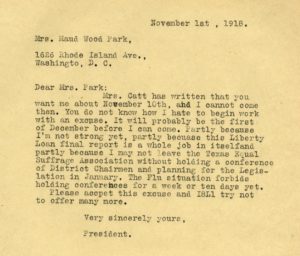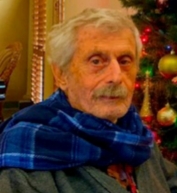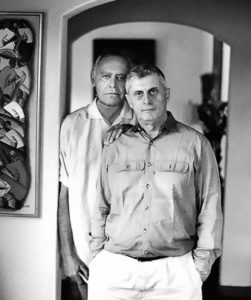
Jenna Guinn, practicum student from the University of North Texas, shares research and resources related to history of Shasta, the cougar mascot for the University of Houston.
If you attend a UH football game, you will most definitely see the university’s costumed mascot, Shasta the Cougar, doing push ups on the sidelines with each new point scored. However, it wasn’t too long ago that spectators would see a live cougar prowling the sidelines accompanied by her Cougar Guard. Between 1947 and 1989, five live female cougars held the position of the University of Houston’s mascot.
The choice of a cougar as the university’s mascot can be attributed to John R. Bender, who arrived at the university in 1927 as a volunteer football coach. Bender, the former head coach for the Washington State Cougars, held the animal in high regard and suggested naming the university’s new football team after the animal. The student newspaper and student organizations quickly adopted the name. In 1946, the cougar was named the official mascot of the University of Houston.

The Cougar Guard poses with Shasta I for a yearbook photo. (Houstonian)
In 1947, the Alpha Phi Omega fraternity purchased a cougar from a wildlife preserve under the condition that students at the university could crowdfund for the cougar’s cage and habitat. Articles about the crowdfunding efforts and excitement for the cougar’s arrival abound in the university’s newspaper, The Cougar, from the time period. The students were able to raise enough money, and sure enough, the cougar arrived by plane on October 17, 1947 just in time to attend her first football game the next day. A contest to choose a name for the new mascot was underway shortly after her arrival. Among 225 entries, student Joe Randol won the contest with the following submission: “Shasta (She has to). Shasta have a cage, Shasta have a keeper, Shasta have a winning ball club, Shasta have the best.” Alpha Phi Omega created the Cougar Guard, a select group of members that were responsible for Shasta’s care.
Shasta Ⅰ was not only the university’s first mascot. Serving from 1947-1962 she also held the post for the longest of all the cougars. Shasta Ⅰ lived at the Hermann Park Zoo and attended sporting events chaperoned by the Cougar Guard. In 1953, she was involved in an accident and lost one of her front toes on the way to a game. Tradition says that the opposing team, the University of Texas, mocked UH by imitating the injury. The Cougars, however, adopted the gesture as a symbol of pride and now at game time, Cougar fans show their support by making the “cougar sign,” folding the ring finger of the right hand toward the palm. Shasta Ⅰ also had three cubs: Tom Jr, Shorty, and Hasta, all of whom made an appearances in the pages of the Houstonian from time to time. Shasta Ⅰ retired in 1962.
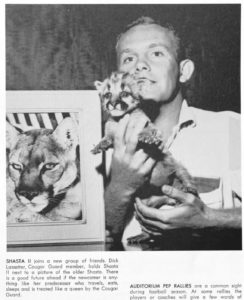
The debut of Shasta II next to a photo of her predecessor. (Houstonian)
Shasta Ⅱ was the university’s mascot from 1962-1965. She made her debut at just 5 weeks old at an October 1960 pep rally, and was in training until Shasta Ⅰ retired, at 14 years old. She had the shortest reign due to unruly, predictably cougar-like, behavior. A November 1964 article in The Cougar stated, “Although Shasta is bad-tempered, she is appreciated by the students. Besides, cougars are supposed to be mean. The students would like to see the meanness rub off on the UH football team.” She was the first cougar to reside on campus full time in Shasta’s Den, a small enclosure located in the southeast corner of Lynn Eusan Park. Shasta Ⅱ was retired to the Waco Zoo at 5 years old.
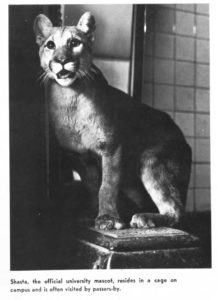
Shasta III, “The Lady,” rests in her on-campus enclosure. (Houstonian)
Shasta Ⅲ, a.k.a. “The Lady” served from 1965-1977, and may have been the most famous of all the university’s cougars. Along with being the university’s mascot, “The Lady” was featured in commercial spots for American Motors. Shasta Ⅲ made her mascot debut during the November 6, 1965 homecoming game. She became an official alumnus in 1977 and retired due to worsening arthritis. Shasta was pulled around the Astrodome in her wagon one last time during the UH Homecoming Game. An anonymous donation of $7,000 was made for a second enclosure for Shasta Ⅳ, so that Shasta Ⅲ could remain in her enclosure on campus. Shasta Ⅲ was one of the most beloved cougars that ever prowled university grounds, she even graces the 1975 cover of the Houstonian.
Shasta Ⅳ, a.k.a. “Baby Shasta” was promoted to university mascot when she was just 11 weeks old in 1977. However, when “Baby” grew up, the Cougar Guard could not control her, much like her predecessor Shasta Ⅱ. “Baby Shasta” retired in 1980 at the young age of three. Shasta Ⅳ did make a lasting impression on one of the Cougar Guard members charged with her care. Justin Leiber, an author, philosopher, and graduate of the University of Houston, was so impressed by Shasta Ⅳ that he made her a recurring character in two of his science fiction novels. An article in the 1989 Houstonian details their close relationship.
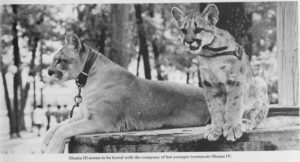
Shasta III and Shasta IV share reside together in their on-campus enclosure after an anonymous donation was made to expand the enclosure. (Houstonian)
Shasta Ⅴ made her debut on November 4, 1980. She held the position of beloved mascot for nine years when she was euthanized due to kidney failure in 1989. When Shasta Ⅴ’s reign came to an end there was much discussion over the ethics of housing a wild animal on campus and controversy amongst staff and students over the size of Shasta’s Den and her quality of life. There were even attempts to fundraise for a larger enclosure before Shasta Ⅴ’s passing. In 1989 Interim President George Magner ruled that the tradition of a live mascot would end with the death of Shasta Ⅴ, bringing a 42 year tradition to an end. The decision was made based on liability, funds, and animal exploitation/rights. However, the decision went against the majority opinion of the students at the time.
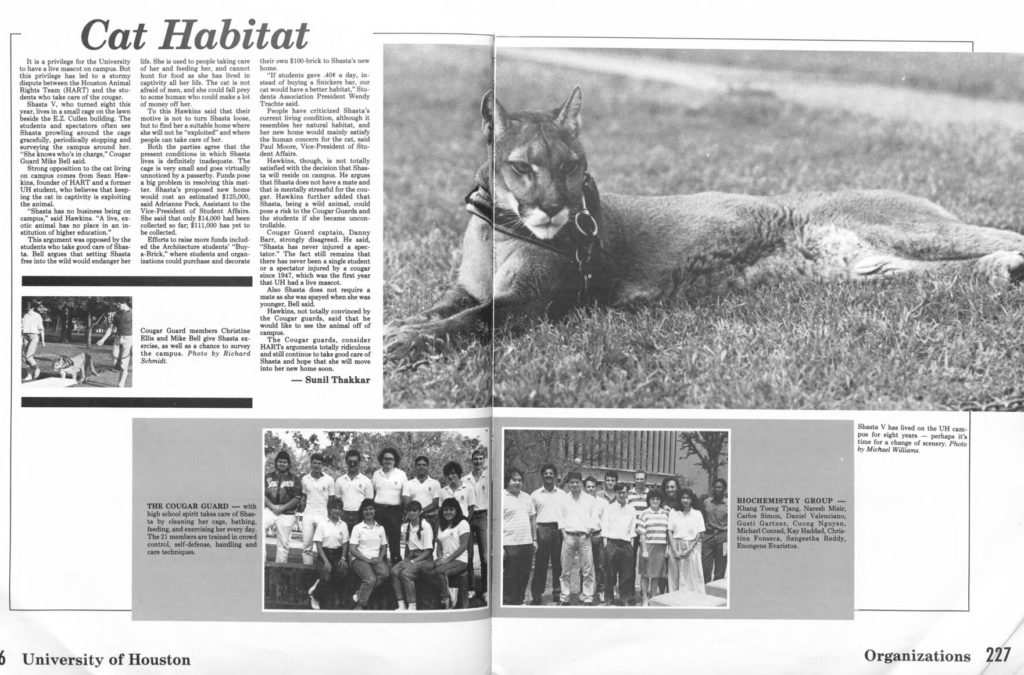
Shasta V appears in an article in the 1988 Houstonian debating the ethics of keeping a wild cougar on campus. (Houstonian)
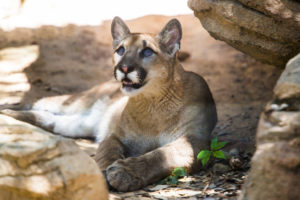
Shasta VI calls the Houston Zoo his home. (Houston Zoo)
It would be 22 years before UH was blessed with another iteration of Shasta. In 2011, the Houston Zoo rescued a cougar cub whose mother had been illegally killed in Washington State. How fitting that Shasta Ⅵ would come from the very place that inspired John R. Bender back in 1927. The zoo entered into a partnership with UH Alumni Association and on March 24, 2012 Shasta Ⅵ was introduced to the public and became an ambassador for the university. Shasta Ⅵ is the first live male cougar mascot. While Shasta Ⅵ resides exclusively at the Houston Zoo, he does attend important university events…via webcam. Before the biannual ring ceremonies, class rings spend the night in the cougar habitat to be blessed by Shasta. Students can visit Shasta Ⅵ at the zoo for free with a student ID.
The University of Houston’s Specially Collections Department has many resources that highlight Shasta Ⅰ-Ⅴ, including pictures and articles in archived versions of The Cougar and Houstonian.
Katy Allred, graduate student assistant from the University of North Texas Library Science program, provides us with insight into the lives of Dorothy Hood, José María Velasco Maidana, and Khory the Cat.
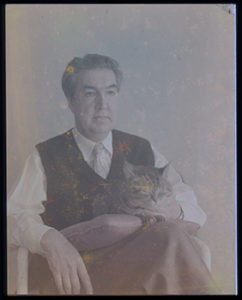
José María Velasco Maidana and Khory (José María Velasco Maidana Papers, University of Houston Special Collections)
Dorothy Hood and José María Velasco Maidana met in Mexico City in the 1940s and married in 1946. She was a young American painter and writer starting to make a name for herself, and he was a well-known Bolivian composer and conductor 20 years her senior. The two never had children together, but they did have an important family member early in their marriage who accompanied them on their many travels – a cat named Khory. Khory the cosmopolitan cat traveled by rail from Mexico to New York City, sat for a portrait with Velasco Maidana, and was even featured in a Houston Chronicle article by Ann Holmes, the newspaper’s fine arts editor who wrote: “The Maidanas are on their way to New York for a five-month stay, in company with their creole cat, name Khory, who travels-with no sense of disgrace at all-in a birdcage!”
Hood and Velasco Maidana traveled together often, but sometimes their work obligations took them in different directions. Velasco Maidana wrote several letters to Dorothy during these times apart in the late 1950s, in which he would sometimes update her on Khory’s activities, and he always signed off with salutations from both himself and Khory the cat – or sometimes just from Khory. In one letter, Velasco Maidana writes, “[Khory] received the kisses that you sent him and for his part today sends you many meows, which I hope sounds very sweet to your ears.”
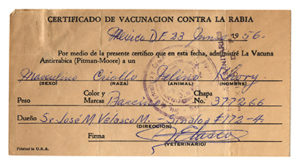
Rabies vaccination card for Khory the Cat (José María Velasco Maidana Papers, University of Houston Special Collections)
The story of Khory the cat is a small facet of the rich and varied materials in the Dorothy Hood Papers and the José María Velasco Maidana Papers, which are both now open for research. Hood’s materials include correspondence, scrapbooks, exhibition programs, writings, including manuscripts of her unpublished autobiography, photographs, publicity and press, and realia that paints a picture of a woman making her living as an artist in Houston in the last half of the 20th century. Velasco Maidana’s collection includes handwritten musical scores of his compositions, correspondence, scrapbooks, press, recordings of performances of his music, and a variety of materials related to the Amerindia ballet he composed, including the scores, paintings of costume designs, choreography notes, and correspondence. The University of Houston Special Collections is currently open by appointment; for more information, please contact Christian Kelleher at cdkelleher@uh.edu.
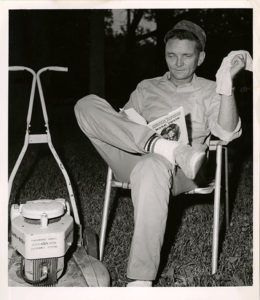
Photograph of Leon Hale via the Leon Hale Papers, University of Houston Special Collections.
In a journalistic career that has spanned over 65 years, with a daily column at the Houston Post that ran from 1948-1984 and the Houston Chronicle from 1984-2014, Leon Hale has literally written about the who, what, when, where, and why that so many journalists attempt to capture. His folksy, plain, straightforward style of writing, as he eschewed fancy complex words, elevated the ordinary musings and experiences into the extraordinary which would have his readers laugh out loud or cry, sometimes both, and in the process take his readers along on his adventures to small towns and locales all across Texas and beyond.
Nothing was too mundane or ordinary to write about, whether it was his personal experience of trusting and biting into a jalapeño pepper at a roadside store near Somerville and then describing its agonizing effects in detail, to the little things we all notice when the power goes out–the quiet, the darkness, neighbors congregating outside, and especially no A/C in the summer.
It’s these little slices of humanity and the interesting cast of characters that he has come across along life’s journey as a reporter that has endeared him to many of his faithful readers along the way for so many years. He’s touched many lives as the history of families and the places he has visited are captured in his daily columns with the Houston Post.
The Leon Hale Papers are part of the Houston & Texas History Research Collection at the University of Houston Special Collections.
As we unveil our new digital exhibit, 100 Years of Progress: The Fight Marches On, celebrating the centennial of the passage and ratification of the 19th amendment in these times of COVID-19 and amidst a national call for social justice and equality all across the nation, let’s not forget that the women that brought about much needed change for the right to vote, faced equally great challenges during their own time. For historical context, they were dealing with the aftermath of World War I in which the world was weary of a prolonged conflict as well as the global spread of the 1918 influenza pandemic which would kill an estimated 50 million people all around the world. Texas Suffragist, Minnie Fisher Cunningham, was afflicted from the “Spanish Flu” and would recover as documented in a letter she wrote as President of the Texas Equal Suffrage Association to Mrs. Maud Wood Park in November of 1918.
If we learn anything from history and the work from Suffragettes all across the nation, it is that with grit, determination, and their eyes on the end goal of having the 19th Amendment ratified by Congress, neither a global pandemic nor a World War would derail their efforts. Through their grassroots activism in their communities, to lobbying local, state, and national representatives, to bending the ear of a US President, they would not be denied in their efforts as they would find a way. They would become united in voice and action as an immovable force in which once their momentum has started, nothing would be able to stop nor stand in their way.
The creation of this exhibit has been a unique experience to say the least. Working with public history student, Jennifer Southerland, since this past fall and early spring, we had mapped out and selected many of the materials. Then the COVID-19 pandemic hit in late March, putting a stop to our physical process and planning as we could no longer go into the office. Rather than stop all the work and planning that had gone before, Jennifer and I continued to meet weekly via phone, and working collaboratively with online tools such as Zoom, Google Docs, and Google Sheets to arrange the digital materials (including the Minnie Fisher Cunningham Papers and Mary Ellen Ewing vs the Houston School Board) that were available, requesting scans of other materials that had not been digitized, drafting descriptive text for the materials, and brainstorming on potential themes that would emerge from the exhibit.
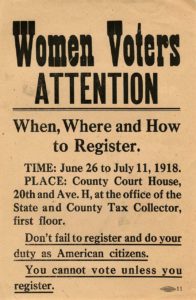
“Women Voters Attention – When, Where and How to Register,” 1918 flier distributed to inform women on how to register to vote, featured in the current exhibition
With so many face to face gatherings, events, and programs being cancelled due to COVID-19 the thought process in the creation of this digital exhibit has focused on how we could organize the digital materials we already have into a virtual exhibit which is openly accessible to the public whether it be in their homes or home offices. Just as the early suffragists found a way to overcome despite all the odds, we wanted to use the technology at our disposal to still make this happen despite the challenges posed by COVID-19 and social distancing.
In a more normal setting a physical exhibit would be created first with physical materials selected, matted, backed, and captions created before they are arranged and installed into exhibit cases within the library. We’ve had to take the opposite approach of working backwards, creating a digital exhibit first, which we know will be remotely available to the public, and then later this fall install the physical materials into the cases based on the digital exhibit. What we’ve learned is that although the pandemic has changed the logistics and dynamics of how an exhibit may ultimately be put together, we’ve still found a way to virtually document and celebrate the work of Suffragists all across the nation. This exhibit is dedicated in honor of their grit, determination, and spirit of fighting on.
Nicholas John Tsacrios passed away in Sarasota, Florida on May 4, 2020 at the age of 92 from natural causes. Nick was the long-time companion of José Quintero, legendary Tony Award winning Broadway Director and Founder of Circle in the Square in Manhattan.
Nick was born on November 5, 1927 in Clearwater, Florida to Greek parents. His loving mother Sevasti Tsacrios passed away when Nick was only two years old. Nick was raised by his loving father John M. Tsacrios, Sr. who was a prominent pioneer merchant and civic leader in Clearwater, Florida.
Nick is survived by one brother Manuel “Buster” Tsacrios and a half-sister Maria John Tsacrios Molett and half-brothers John M. Tsacrios, Jr. and Frank John Tsacrios.
Nick was the eighth of nine children and the first to graduate from college due to the encouragement and support of his stepmother Xanthippi Tsacrios who he and José loved very much. Nick studied at the University of Florida and at the University of Madrid in Spain where he learned Spanish and became a bullfighter.
Nick was a creative adventurous person who loved cooking, entertaining, gardening, the arts, and caring for animals especially his loving cat Gato. He was renowned for his wonderful sense of humor that he got from his father.
Nick met José Quintero in the 1950’s in New York City when Nick was at the height of his career as an advertising executive in Manhattan. Nick and José had endearing friendships throughout their lives with renowned artists Liv Ullmann, Gloria Vanderbilt, Vanessa Redgrave, Tennessee Williams, Mexican star Dolores del Rio, Jason Robards, Roddy McDowall, Charles Nelson Reilly, dancer and choreographer Martha Graham, Greek film actor and artist Vassili Lambrinos, and Angelina Fiordellisi of the Cherry Lane Theater in New York City.
Nick was a significant source of support for José Quintero’s work as a lecturer and professor at the University of Houston, Florida State University, the Burt Reynolds Institute for Film and Theatre in Palm Beach, Florida, and during Quintero’s theater workshops in Los Angeles, California, and directing plays at Houston’s Alley Theater. Nick and José worked closely for many years with their beloved friend Sydney Berger, the revered former Director, Producer, and Mentor of the University of Houston School of Theatre & Dance.
Nick was instrumental in establishing the José Quintero Archives at the University of Houston which also houses the José Quintero Theater. Nick maintained a supportive relationship with the José Quintero Theater in New York City.
During Nick’s later years in Sarasota he was blessed to be surrounded by many loving, caring friends especially George Karabatsos from Saint Barbara’s Greek Orthodox Church where Nick loved to volunteer.
Memorial services were held at Holy Trinity Greek Orthodox Church in Dallas, Texas, Saint Barbara’s Greek Orthodox Church in Sarasota, Florida, and Nick’s beloved Saint Nicholas Cathedral in Tarpon Springs, Florida.
John M. Tsacrios, Jr. brother of Nicholas John Tsacrios, provided this memorial.
